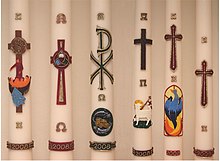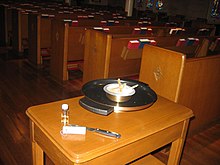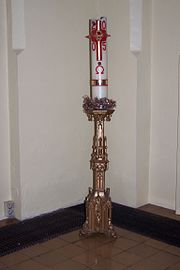Can a Paschal Candle Be Used Again
- This article describes the Paschal candle of the Western Churches. For the Paschal triple-candle used in Eastern Orthodox and Byzantine Catholic churches run across Paschal trikirion.

A Paschal candle is a big, white candle used in liturgies in Western Christianity (viz., the Roman Catholic Church building, the Lutheran Churches, the Anglican Communion, and the Methodist Churches, among others). A new Paschal candle is blessed and lit every year at Easter, and is used throughout the Paschal season which is during Easter and and then throughout the yr on special occasions, such equally baptisms and funerals.
The equivalent of the Paschal candle in the Western Orthodox Church is the Paschal trikirion, which differs in both fashion and usage.
Etymology [edit]
The term Paschal comes from the Latin give-and-take Pascha, which came from the Hebrew word Pesach, which in Hebrew means 'Passover', and relates to the Paschal mystery of conservancy. It is sometimes referred to every bit the "Easter candle" or the "Christ candle."
Clarification [edit]

For congregations that use a Paschal candle, it is the largest candle in the worship infinite. In most cases today the candle will brandish several common symbols:
- The cross, which is the most prominent symbol and well-nigh clearly identifies information technology as the Paschal candle
- The Greek letters alpha and omega, which symbolize that God is the starting time and the stop (from the Book of Revelation)
- The yr when the particular candle is being used, which represents God among the present congregation
- Five grains of incense (most often scarlet), which are embedded in the candle (sometimes encased in wax "nails") during the Easter Vigil to correspond the v wounds of Jesus: the 3 nails that pierced his easily and feet, the spear thrust into his side, and the thorns that crowned his head.
In the [medieval] Church, Paschal candles oft reached a stupendous size. The Paschal candle of Salisbury Cathedral was said to have been 36 feet (eleven metres) tall. Today, in the United states of america and Southern Europe (e.thousand., Italian republic and France) the candle is approximately four inches (10 centimetres) in diameter and 36 to 48 inches (90 to 120 centimetres) alpine; in Northern Europe the candle tends to be shorter in height (19 to 24 inches/50 to 60 centimetres) and wider in bore (3 to 5 inches/viii to 13 centimetres).
Usage [edit]
Easter Vigil [edit]
For churches that celebrate the Easter Vigil on the night of Holy Saturday, the ceremonial lighting of the Paschal candle is one of the most solemn moments of the service. The Easter Vigil liturgies of the Roman Catholic, Lutheran, Anglican, Methodist and Presbyterian Churches are nearly identical.[1]
On Maundy Th of the aforementioned week the entire church building is darkened by extinguishing all candles and lamps. This represents the darkness of a earth without God.

Brazier used for kindling the "New Burn"
At the opening of the Easter Vigil a "new burn" is lit and blessed. The government minister will trace the symbols (mentioned above) on the Paschal candle, saying words similar to: "Christ, yesterday and today, the start and the end, the Blastoff and Omega. To Him belongs all time and all the ages; all glory and dominion is his now and forever. Amen." They and then insert v grains of incense (reminiscent of the nails used to fasten Christ on the Cross) on the five points of the cross , proverb: "By His holy and glorious wounds may Christ our Lord guard and keep us."
The Paschal candle is the first candle to be lit with a flame from this sacred fire, representing the light of Christ coming into the world. This represents the risen Christ, as a symbol of low-cal (life) dispelling darkness (death). As information technology is lit, the minister may say words like to: "The lite of Christ, ascent in Glory, dispel the darkness of our hearts and minds."

Deacon chanting the Exultet beside a Paschal candle
Typically, the worshiping assembly so processes into the church led past the Paschal candle. The candle is raised three times during the procession, accompanied by the chant "The light of Christ" to which the associates responds "Thank you be to God".
In some communities, it is common for nearby churches of different Christian denominations (due east.g. Catholic, Lutheran, Anglican, Methodist and Presbyterian) to make the new Easter Fire together and and then after this, each congregation processes back to their own church building with their ain Paschal Candle for their Easter Vigil celebration; this is considered to be a fostering of ecumenism.
Following the procession the Exultet is chanted, traditionally by a deacon, simply it may be chanted past the priest or a cantor. The Exultet concludes with a blessing of the candle:
Accept this Easter candle,
a flame divided but undimmed,
a colonnade of fire that glows to the honor of God.
(For it is fed past the holy melting wax, which the female parent bee brought forth
to brand this precious candle.)
Permit information technology mingle with the lights of sky
and proceed bravely burning
to dispel the darkness of this dark!
May the Morn Star which never sets
find this flame still burning:
Christ, that Morning Star,
who came back from the dead,
and shed his peaceful light on all humanity,
your Son, who lives and reigns for ever and e'er.
Amen.
From the New Roman Missal:
On this, your nighttime of grace, O holy Father, accept this candle, a solemn offer, the work of bees and of your servants' hands, an evening sacrifice of praise, this souvenir from your most holy Church. But now we know the praises of this colonnade, which glowing burn down ignites for God's honour, a burn down into many flames divided, even so never dimmed by sharing of its light, for it is fed by melting wax, drawn out by mother bees to build a torch so precious. O truly blest night, when things of heaven are midweek to those of earth, and divine to the human.
Therefore, O Lord, we pray you that this candle, hallowed to the honor of your name, may persevere undimmed, to overcome the darkness of this dark. Receive information technology every bit a pleasing fragrance, and allow it mingle with the lights of heaven. May this flame be establish still burning by the Morning Star: the ane Morning Star who never sets, Christ your Son, who, coming back from decease's domain, has shed his peaceful light on humanity, and lives and reigns for ever and e'er.
R. Amen.
In some traditions, the base of the candle may be ritually immersed in the baptismal font before proceeding with the residuum of the service.
This candle is traditionally the one from which all other lights are taken for the Easter service.
Other times of the year [edit]

The candle remains lit at all worship services throughout Easter season which ends on Pentecost Sunday, (or in some[ specify ] traditions until Ascension Day, when it is extinguished just subsequently the Gospel), during which time information technology is located in the sanctuary close to the altar. After the Easter flavor, it is frequently placed near the baptismal font. Before 1955, the pick existed of approving the baptismal font on the Vigil of Pentecost, and this was the merely time the Paschal candle would be lit at services after Ascension.
The Paschal candle is likewise lit during baptisms to signify the Holy Spirit and fire that John the Baptist promised to those who were baptised in Christ. During the baptismal rite in many traditions, a pocket-sized lit candle will be given to the newly baptised by a member of the community, with words similar to, "Let your low-cal and then shine earlier others, that they might see your good works and glorify your Father in sky." (Matthew 5:16)
The Paschal candle is also lit and placed most the casket or urn during funeral services such as the Mass of Repose and the Mass of Requiem. It is important to note that in one case lit the candle should remain burning until finished. This is to signify the promise of the resurrection into which Christians are baptised.
Eastern usage [edit]
In the Eastern Orthodox and Byzantine Catholic churches, at that place is no directly correspondence to the Western Paschal candle. Notwithstanding, throughout Bright Week, the priest carries a cross and paschal trikirion at all of the services, peculiarly when censing, during the Footling Entrance or when giving the Paschal greeting. The trikirion consists of three lit candles in a candlestick, which the priest carries in his left manus. In the Slavic tradition, the three candles may be white or different colors: green, red, bluish. The deacon likewise carries a special Paschal candle which is a single large candle whenever he leads an ektenia (litany) or censes.
References [edit]
- ^ Ramshaw, Gail (2004). The Three-Day Feast: Maundy Th, Skillful Friday, and Easter. Augsburg Books. p. 7. ISBN9780806651156.
Many Christians are already familiar with the ancient, and now recently restored, liturgies of the Three Days: Maundy Th, Good Friday, and the great Easter Acuity service of low-cal, readings, baptism, and communion. The worship resources published by the Evangelical Lutheran Church in America, the Episcopal Church, the United Methodist Church, the Presbyterian Church UsaA. and the Catholic Church include nigh identical versions of these liturgies.
External links [edit]
- The Candle Carving Site
- Herbermann, Charles, ed. (1913). . Cosmic Encyclopedia. New York: Robert Appleton Company.
Source: https://en.wikipedia.org/wiki/Paschal_candle
0 Response to "Can a Paschal Candle Be Used Again"
Post a Comment